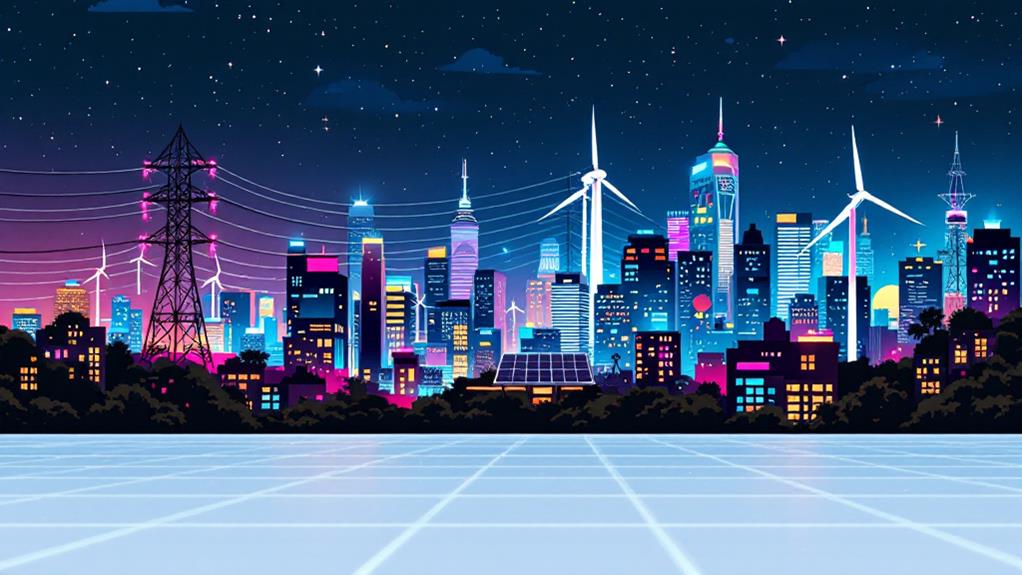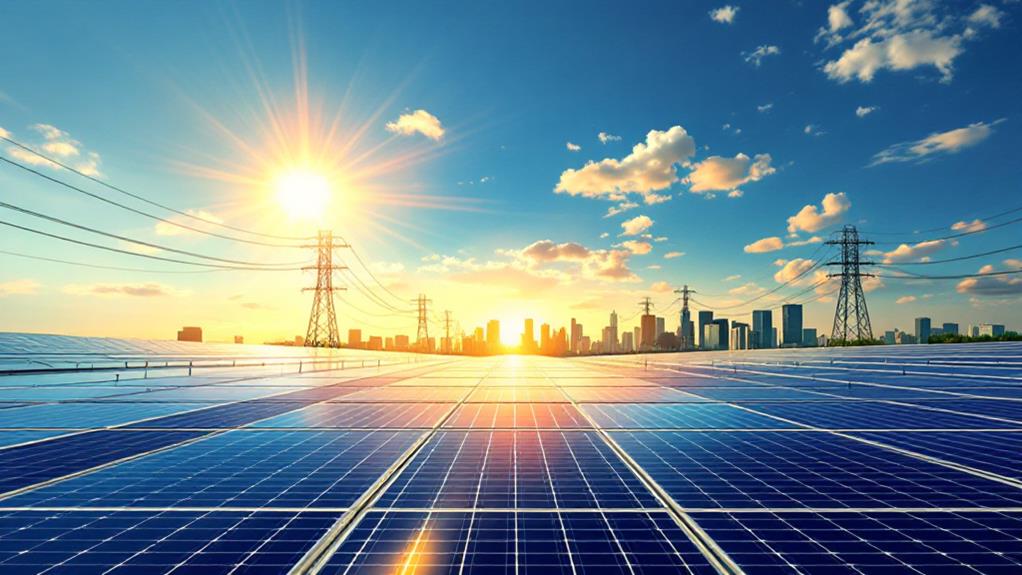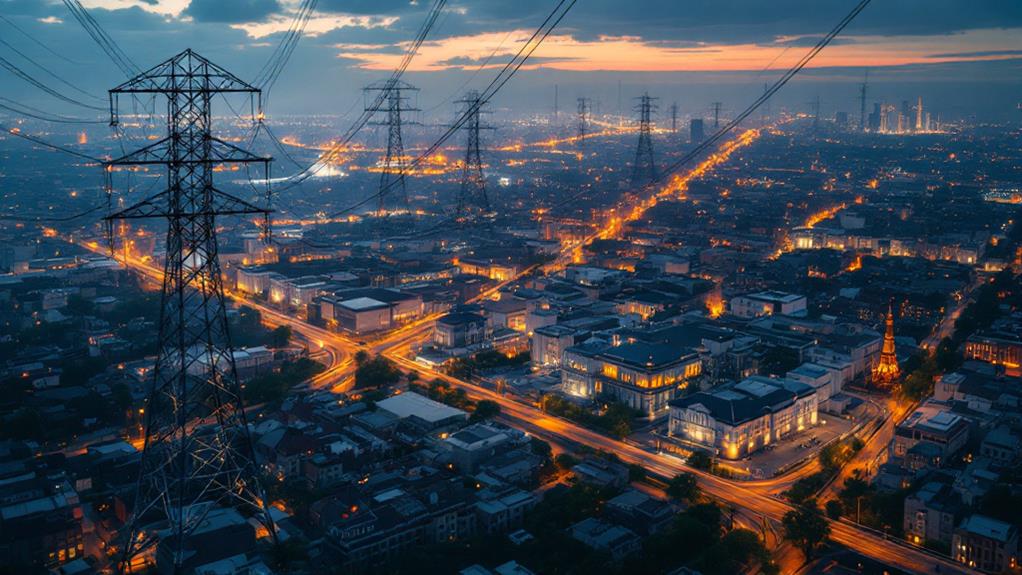How Many Electric Grids Are in the U.S.? A Breakdown of Regional Power Networks
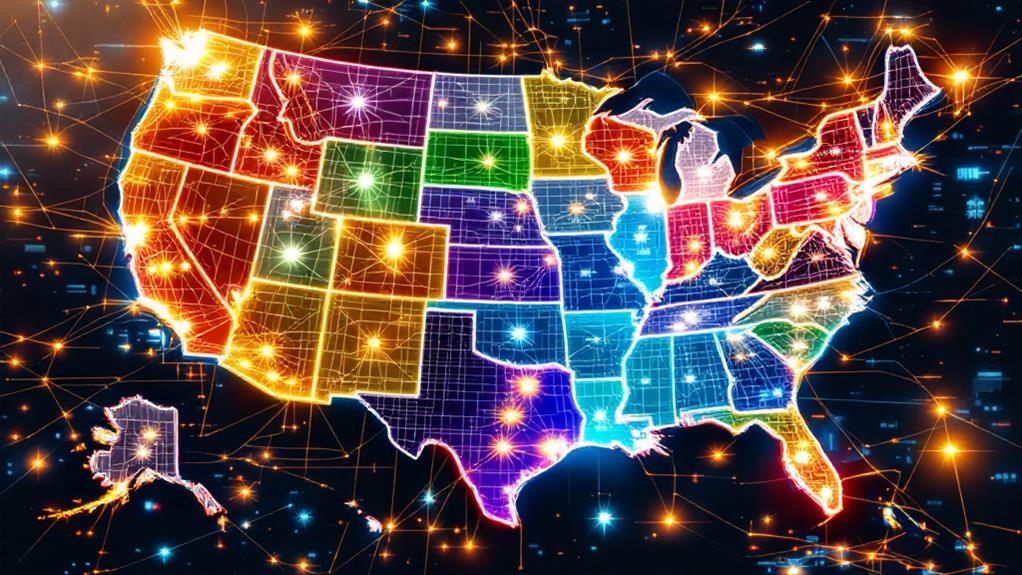
You'll find five primary electric grid regions in the U.S.: the Eastern Interconnection, covering from the eastern seaboard to the Great Plains; the Western Interconnection, stretching from the Rocky Mountains to the Pacific; and the Texas Interconnection, which functions independently and is managed by ERCOT. Alaska and Hawaii each have unique systems, with Alaska's grid comprising microgrids due to its remoteness and Hawaii operating independent grids for each island. These regional networks face challenges like renewable energy integration and infrastructure upgrades, revealing intricate details that connect the complexities of U.S. power management. Investigate further to uncover these networks' specifics.
Overview of U.S. Power Grids
The backbone of modern civilization, U.S. power grids are vast networks that deliver electricity from producers to consumers across the country. As you investigate these systems, you'll notice the ongoing evolution into a smart grid, designed to improve efficiency and reliability. Smart grids facilitate renewable integration, allowing solar and wind energy to seamlessly contribute to the national power supply. This change supports grid resilience, ensuring that the grid can withstand and recover from disruptions.
Energy storage plays a vital role in this modernization. By storing excess energy, especially from renewable sources, the grid can meet demand even when the sun isn't shining or the wind isn't blowing. Through distributed generation, electricity is produced closer to where it's used, reducing transmission losses and enhancing efficiency. Demand response programs empower you to adjust your energy use during peak times, easing strain on the grid and reducing costs.
However, with these advancements come cybersecurity threats. Protecting the grid from attacks is paramount to maintaining its integrity. By addressing these challenges, you're contributing to a robust and future-ready power grid that meets the evolving needs of society.
The Eastern Interconnection
Spanning from the eastern seaboard to the Great Plains, the Eastern Interconnection forms one of the largest power grid systems in the United States. It covers a vast area, making it both a marvel and a challenge. You might wonder how this interconnected web manages to keep the lights on for so many.
The Eastern grid faces several challenges, including:
- Eastern grid challenges: Balancing demand and supply across such a broad region isn't easy, especially with varying local policies and energy sources.
- Renewable energy integration: Incorporating solar and wind power into the grid requires careful planning to maintain stability and reliability.
- Cybersecurity threats: Protecting such an extensive system from digital attacks is a top priority.
Despite these challenges, the interconnection offers significant benefits. You'll find that regional energy efficiency can be improved through shared resources and better grid modernization efforts. Infrastructure investment strategies play an essential role in maintaining and upgrading this network, ensuring it can handle future demands and innovations.
Energy policy implications are also at play, as decisions made at regional levels can impact the efficiency and sustainability of the grid. As you investigate the Eastern Interconnection, consider how these factors converge to power millions of lives daily.
The Western Interconnection
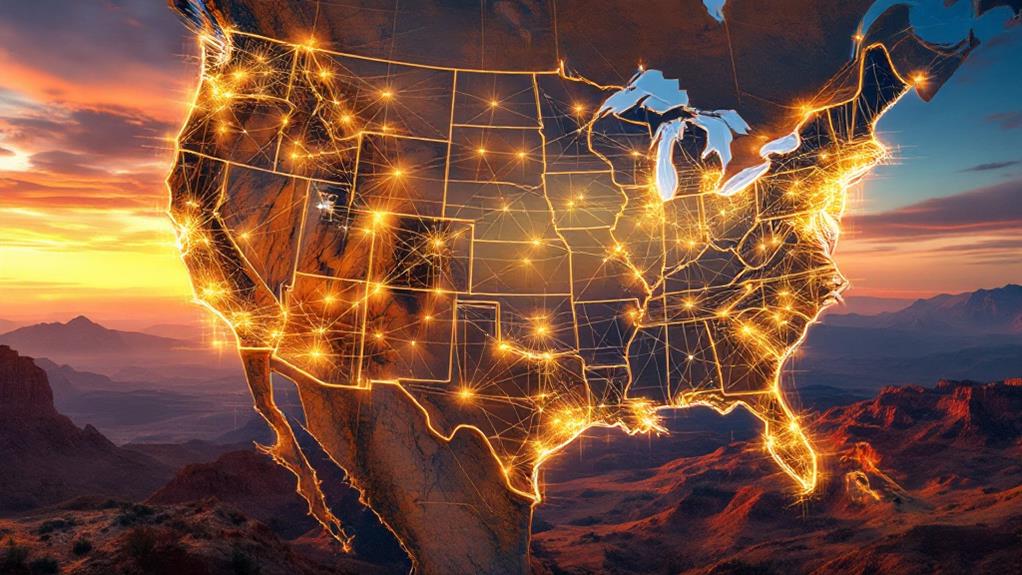
Imagine a vast network stretching from the Rocky Mountains to the Pacific Ocean—this is the Western Interconnection. You're dealing with a grid that spans numerous states, all influenced by the unique Western climate. This climate provides abundant opportunities for renewable resources like solar and wind. To guarantee grid reliability, the Western Interconnection requires advanced infrastructure upgrades and technological advancements. These improvements help manage the challenges posed by integrating renewable resources and maintaining consistent energy supply.
Energy trading plays a significant role here, as it allows different regions to share electricity, optimizing resource use. However, regulatory challenges can complicate this process, requiring careful navigation to foster effective regional cooperation. You must be keenly aware of environmental impacts when balancing energy production and consumption practices.
Demand response initiatives are essential for handling peak energy usage times, guaranteeing the grid remains stable and efficient. By coordinating these efforts, the Western Interconnection can better manage energy needs while reducing strain on the system. It's a delicate balance, but with continued focus on technological advancements and cooperation, the Western Interconnection can meet the demands of modern energy consumption while minimizing environmental impact.
The Texas Interconnection
Unlike other regions, Texas operates its own unique electric grid known as the Texas Interconnection. This grid is a demonstration of Texas power and grid independence. Unlike the Eastern or Western Interconnections, Texas is primarily managed by the Electric Reliability Council of Texas (ERCOT). This setup allows for greater control over energy regulation, but it also means Texas must handle its own transmission constraints and market dynamics.
You're probably wondering how Texas manages its energy needs with such independence. Here's what makes the Texas Interconnection stand out:
- Grid Independence: Texas isn't tied to the national grid, which means it can avoid federal energy regulation and make swift decisions tailored to its needs. However, it also limits the ability to import power during shortages.
- Renewable Integration: Texas leads the nation in wind energy production, showcasing impressive renewable integration. The grid's flexibility helps accommodate these resources, but rapid growth presents its own challenges.
- Market Dynamics: The Texas power market operates on a deregulated, competitive basis, which can lead to both innovation and volatility. Market prices fluctuate based on demand and supply, impacting consumers directly.
Understanding these factors is essential to grasp why Texas remains distinct in the U.S. electric grid landscape.
Alaska's Unique Grid System
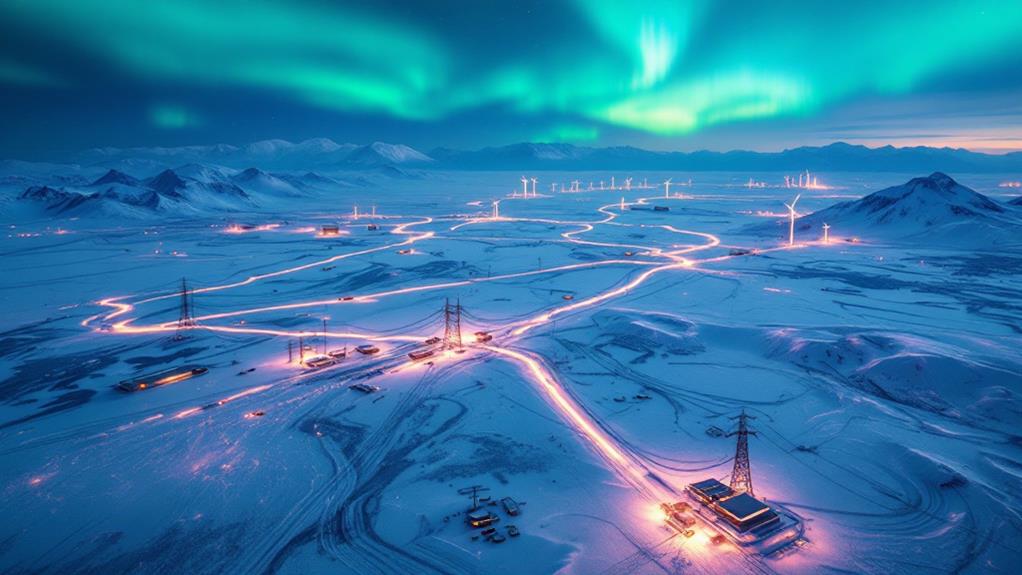
Alaska's Unique Grid System offers a fascinating glimpse into how a remote and rugged region manages its energy demands. Unlike the contiguous U.S., where large interconnected grids are the norm, Alaska's energy infrastructure is fragmented. You'll find numerous microgrids catering to remote communities scattered across vast distances. These microgrids rely heavily on renewable resources like wind, solar, and hydro to guarantee grid stability amid harsh climates.
In Alaska, power generation is a complex task due to its isolated location and extreme weather conditions. Transmission lines must traverse challenging terrains, adding to infrastructure challenges. These lines are often shorter compared to the continental U.S., given the geographical spread and local regulations guiding their construction. This setup prioritizes energy independence, allowing communities to rely less on distant power sources.
With these unique conditions, Alaska has turned its natural challenges into opportunities, utilizing renewable resources to meet its energy needs. However, local regulations and infrastructure challenges still pose hurdles. By focusing on sustainable solutions and improving technology, Alaska continues to adapt its grid system. This balance of innovation and adaptation guarantees that even in remote locations, reliable energy remains a priority.
Hawaii's Independent Grids
Situated in the middle of the Pacific Ocean, Hawaii's independent grids present a distinct energy landscape marked by isolation and creativity. Unlike the mainland U.S., Hawaii's grids aren't interconnected, which means each island must rely on its own resources and strategies to meet energy demands. This setup gives Hawaii grid independence but also presents unique island grid challenges.
Hawaii renewable energy initiatives are at the forefront of addressing these challenges. The state has adopted ambitious Hawaiian energy policies focused on sustainability and reducing fossil fuel dependence. Localized energy solutions like Hawaii solar integration are key components of this strategy. Solar panels are widely used, taking advantage of the abundant sunshine to generate power.
You'll find that energy storage systems play a vital role in Hawaii's grid resilience strategies. Because of the variable nature of solar energy, storing excess power for use during cloudy days or at night is fundamental. Here are some interesting points about Hawaii's energy landscape:
- Hawaii's goal is to reach 100% renewable energy by 2045.
- Each island operates its own grid independently.
- Creative solutions are constantly being developed to tackle energy storage and distribution.
Role of Regional Transmission Organizations
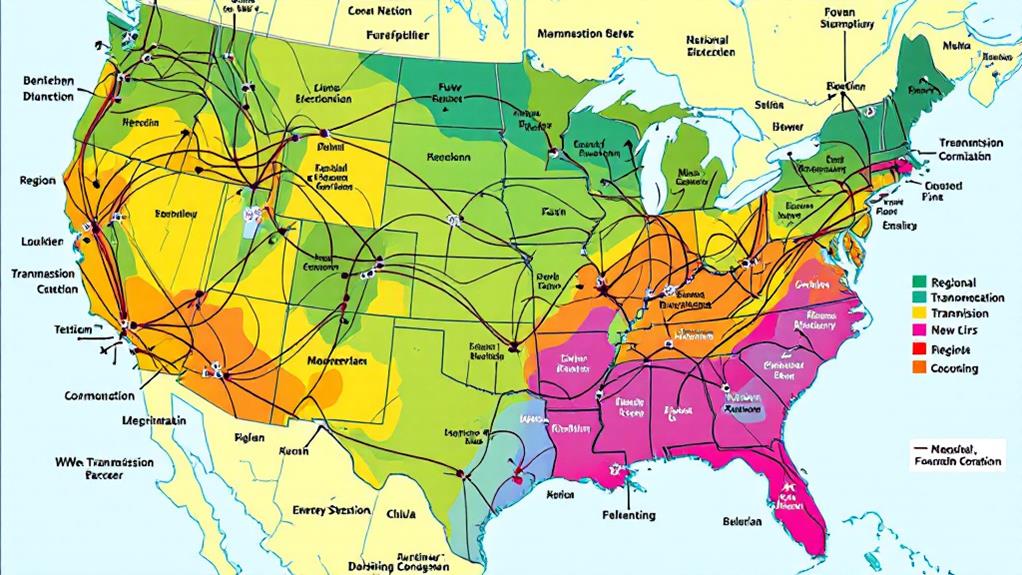
Coordination is the backbone of the U.S. energy landscape, and Regional Transmission Organizations (RTOs) play a vital role in this intricate system. You can think of RTOs as the traffic controllers of electricity, ensuring transmission efficiency and seamless market coordination. They manage how electricity flows across large regions, balancing supply and demand to maintain reliability standards.
RTOs face numerous regulatory challenges, particularly regarding renewable integration. As renewable energy sources like wind and solar become more prevalent, RTOs must adapt their systems to accommodate these variable power sources. This requires grid modernization initiatives, ensuring that the infrastructure can handle fluctuating energy inputs while maintaining stability.
Stakeholder collaboration is significant in this process. RTOs work with utility companies, government agencies, and other stakeholders to develop strategies that address these challenges. Cost allocation is another important aspect, as RTOs determine how the financial burden of grid improvements and expansions is shared among participants.
Impact of Grid Interconnections
In the interconnected world of electric grids, the importance of grid interconnections can't be overstated. By linking diverse regional power networks, you're not only enhancing the reliability of electricity supply but also ensuring that power can be redirected during outages or demand spikes. This interconnectedness plays a crucial role in grid resilience strategies, offering a robust defense against failures and natural disasters.
Grid interconnections bring numerous benefits, and understanding them helps appreciate their significance:
- Enhanced Reliability: You're less likely to experience blackouts because interconnections allow for power sharing across regions.
- Economic Efficiency: By optimizing power flows and reducing redundancies, you can lower costs and improve operational efficiency.
- Renewable Integration: Interconnections make it easier to incorporate renewable energy sources, balancing supply and demand more effectively.
These benefits highlight why grid interconnections are fundamental in modern power networks. They provide the flexibility needed to adapt to unexpected changes and challenges, ensuring a stable electricity supply. As you investigate the world of electric grids, recognizing the role of these interconnections will deepen your understanding of how regional power networks function together to maintain energy security and efficiency.
Challenges Facing U.S. Grids
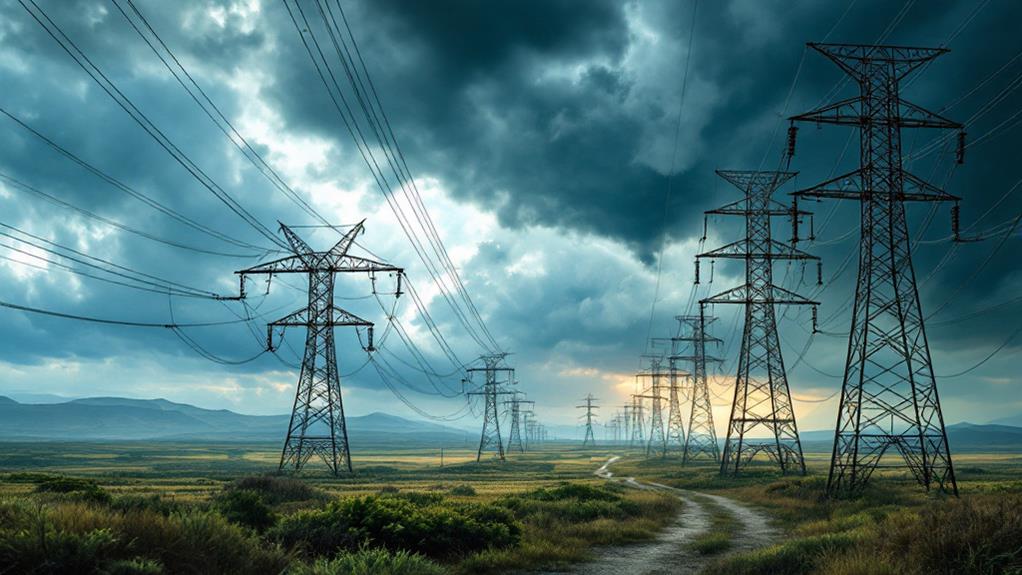
Maneuvering the challenges facing U.S. grids requires a keen understanding of several key issues. Initially, grid modernization efforts are essential as much of the infrastructure is aging, leading to inefficiencies and vulnerabilities. You need to focus on integrating renewable energy sources, which presents both technical and regulatory challenges due to the intermittent nature of resources like solar and wind power. Cybersecurity threats also pose significant risks to grid stability, requiring constant vigilance and advanced security measures.
Moreover, regulatory challenges can complicate progress, as policies often lag behind technological advancements. Guiding through these complexities demands collaboration between federal, state, and local entities, alongside public private partnerships that can drive innovation and investment.
Climate resilience measures are increasingly vital, as extreme weather events strain the grid and lead to outages. You must prioritize strategies that improve the grid's ability to withstand such events. Demand response strategies can help manage peak loads and prevent blackouts by incentivizing consumers to reduce or shift their electricity usage during high-demand periods. By addressing these challenges head-on, you can guarantee a more robust, reliable, and sustainable power network for the future.
Future of U.S. Electric Grids
The future of America's electric grids hinges on innovation and adaptability as they shift to meet modern demands. You'll see significant advancements through smart grid technology and renewable energy integration, empowering you to manage energy consumption more efficiently. These grids are getting smarter, using energy storage solutions to balance supply and demand, while electric vehicle infrastructure expands to support the growing number of EVs.
To guarantee these grids remain resilient, you'll encounter grid resilience strategies and demand response programs designed to handle fluctuations and unexpected challenges. Cybersecurity measures are vital, protecting these systems from potential threats, while decentralized energy systems and microgrid development offer localized solutions for power generation and distribution.
You'll notice policy reforms shaping the landscape, promoting a cleaner, more sustainable energy future. As the grid evolves, expect:
- Increased integration of renewable energy sources, reducing reliance on fossil fuels and lowering emissions.
- Adoption of decentralized energy systems, allowing communities more control over their energy needs.
- Implementation of energy storage solutions, securing reliability even when renewable sources aren't generating power.
These advancements are setting the stage for a more efficient, secure, and dynamic electric grid, ready to meet tomorrow's demands.
